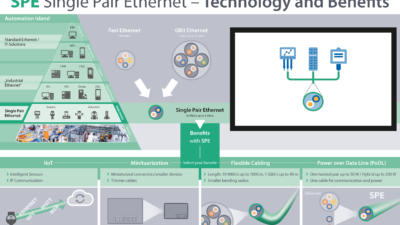Time-sensitive network (TSN)-compatible automation components can create agile and future-proof manufacturing factories.

Time-sensitive networking (TSN) is one of the most transformational developments in standard Ethernet technology. It is an enabling technology for industrial communications that can help to realize operational technology (OT) and information technology (IT) convergence with the goal of substantial enterprise-wide improvements. In effect, TSN and TSN-compatible devices are key to setting up future-proof Industrial Internet of Things (IIoT) frameworks that enhance productivity, flexibility and responsiveness.
TSN is a Layer 2 technology (Data Link) of the open system interconnection (OSI) reference model for communications. Defined by the IEEE 802.1 standards, it provides key functions to make Ethernet deterministic by design. This enhances industrial communications technologies, helping to coordinate network traffic as the volume of data continues to increase with the convergence of IT/OT.
With TSN, all devices on a network are synchronized. This minimizes the likelihood of jitter and prevents any subsequent delay in high-speed data transfer. In addition, TSN supports the prioritization of urgent and regular data, by reserving timeslots for both. During these intervals, only scheduled or time-critical traffic is transmitted, without any interference. As a result, network overload can be prevented, minimizing the risk of data loss.
In practice, these capabilities hold the key to creating future-proof IIoT applications. Providing accurate methods to prioritize the transmission of urgent or mission-critical information, such as control data from the shop floor, allows different types of traffic to be merged on the same TSN-compatible network. The result is flattened, simplified architectures with limited capital expenditure (CAPEX).
These architectures can also increase uptime by streamlining the identification and elimination of network errors. In addition to this, businesses can set up a more flexible infrastructure, where TSN-compatible devices can be easily added, removed or reconfigured.
The convergence of IT and OT is at the core of future-oriented IIoT applications and the ability to transmit multiple information types and protocols, while maintaining low jitter and latency, is essential. By creating a TSN-compatible, unified network of automation devices with TSN functionalities, IT and OT networks can be combined to operate over a converged Ethernet architecture.
This, in turn, enables companies to benefit from the data-driven knowledge generated by different parts of an enterprise as they obtain holistic actionable insights into manufacturing processes. Furthermore, they can create decentralized decision-making strategies to help different parts of the company access relevant data from across the organization to obtain key process information. Ultimately, the in-depth understanding that is generated can be leveraged to improve key performance indicators (KPIs), leading to enhanced performance, productivity, efficiency and end product quality.
TSN offers an opportunity for companies, enhancing industrial communications and providing the tools to realize forward-looking smart manufacturing strategies. The implementation of TSN solutions in network technologies and automation devices is therefore essential to help businesses to succeed in their digital transformation strategies.
– This originally appeared on Control Engineering Europe’s website. Edited by Chris Vavra, web content manager, Control Engineering, CFE Media and Technology, [email protected].


